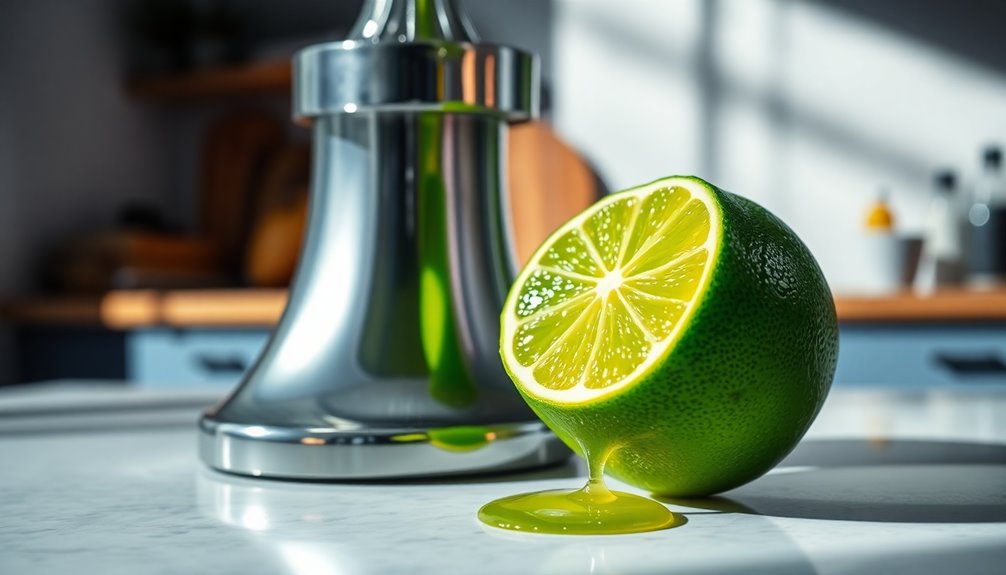To juice a lime with a juicer, start by using room temperature limes for maximum juice yield. Roll each lime on the countertop to loosen the membranes. Slice the lime in half and place it cut side down in the juicer. Press firmly while rotating to extract juice. Expect about one tablespoon of juice per lime. Store any leftover juice in an airtight container to enjoy later. There’s more to discover about the culinary uses of lime juice! For those looking to expand their citrus repertoire, you can also juice a lemon with a juicer in a similar manner. Lemon juice can enhance a variety of dishes, from salad dressings to marinades, providing a zesty kick. Additionally, the refreshing acidity of lime and lemon juice can be used to balance flavors in cocktails and desserts, making them a versatile addition to any kitchen.
Key Takeaways
- Choose room temperature limes for better juice extraction and roll them on the countertop to loosen their membranes.
- Cut the lime in half cleanly to maximize juice yield before placing it cut side down in the juicer.
- Press firmly and rotate the lime half in the juicer to extract all the juice efficiently.
- Expect to get about one tablespoon of juice per whole lime; adjust the number of limes as needed for your recipe.
- Store any leftover lime juice in an airtight container in the fridge for 2-3 days or freeze for longer storage.

Juicing a lime is a simple task that can elevate your recipes with fresh, zesty flavor. Whether you're whipping up a tangy marinade, mixing a refreshing cocktail, or adding a splash of acidity to your favorite dish, fresh lime juice makes all the difference. With a citrus juicer in hand, you can easily extract the juice from limes, maximizing flavor while minimizing effort. Let's dive into how you can make the most of your limes.
To begin, grab your limes and a cutting board. It's best to use limes that are at room temperature for maximum juice yield, so if you've stored your limes in the fridge, let them sit out for a while. You can also roll the limes gently on the countertop to loosen their membranes, making it easier to squeeze out every drop of juice.
Once you're ready, slice the lime in half. A clean cut is essential, as it ensures optimal juice extraction.
Next, take one of the lime halves and place it cut side down into your citrus juicer. Press firmly while rotating the half to help release as much juice as possible from the membranes. You'll feel the juicer do the work, breaking down the lime's structure and allowing the fresh lime juice to flow out.
After getting all the juice from the first half, switch to the other half and repeat the squeezing process. On average, a whole lime yields about one tablespoon or one ounce of juice, so keep this in mind as you juice the limes for your recipe.
If you find you need more juice, simply repeat the process with additional limes, adjusting your quantities based on your recipe requirements. Fresh lime juice can really bring a dish to life, enhancing flavors and adding a delightful zing.
Once you have the amount you need, it's wise to consider what to do with any leftover lime juice. If you've juiced more than necessary, don't worry! You can easily store lime juice in an airtight container in the fridge. It'll stay fresh for about 2-3 days, so you can save it for another culinary adventure.
When you're ready to use that stored lime juice, just remember to give it a quick shake before pouring. This helps mix any sediment that may have formed.
Now, you're all set to incorporate fresh lime juice into your cooking or cocktail-making. Whether you're adding it to a salad dressing, a seafood dish, or a refreshing drink, you'll appreciate the brightness that fresh lime juice brings.
Frequently Asked Questions
Do I Need to Peel Limes Before Juicing?
You don't need to peel limes before juicing.
In fact, keeping the rind on can actually enhance the flavor and aroma of the juice. The oils in the rind contribute to the overall taste, so it's beneficial to leave it intact.
Just cut the lime in half to make it easier to extract the juice. Peeling it might lead to losing some valuable juice, so stick with the rind for the best results.
What Is the Most Efficient Way to Juice Limes?
Juicing limes can feel like squeezing sunshine into a glass!
To do it efficiently, start by rolling the lime on a countertop to loosen its juicy treasures. Slice it in half, then use a citrus juicer with the cut side facing down. Press and twist to extract every drop.
If you've got a lot of limes, an electric juicer can make the task a breeze, delivering about 2 tablespoons of zesty goodness per lime!
How to Juice a Lime Without a Squeezer?
To juice a lime without a squeezer, start by rolling the lime on the countertop to loosen the juice inside.
Then, cut it in half lengthwise. Use a fork or spoon to press against the lime half while twisting, extracting as much juice as you can.
You can also use a handheld reamer for more efficiency.
For an extra boost, microwave the lime for 15-20 seconds to soften it before juicing.
What Should You Do Before Cutting and Juicing the Lime?
Did you know that rolling a lime can increase juice yield by up to 30%?
Before you cut and juice your lime, roll it firmly on the countertop to loosen the membranes. If your lime's cold, let it sit at room temperature for about an hour to improve juicing.
For particularly firm limes, microwave them for 15-20 seconds.
Lastly, wash the lime thoroughly to remove any residues and ensure a fresh taste.
Conclusion
Juicing a lime is as refreshing as a cool breeze on a hot day. With your juicer in hand, you've unlocked the vibrant flavors that lime brings to your dishes and drinks. So, whether you're crafting a zesty cocktail or adding a splash of citrus to your favorite recipe, remember that a little lime goes a long way. Now, go ahead and enjoy that burst of tangy goodness, letting it elevate your culinary creations to new heights!
Cindy thoroughly researches juicing trends, techniques, and recipes to provide readers with practical advice and inspiration. Her writing style is accessible, engaging, and designed to make complex concepts easy to understand. Cindy’s dedication to promoting the advantages of juicing shines through her work, empowering readers to make positive changes in their lives through the simple act of juicing.











